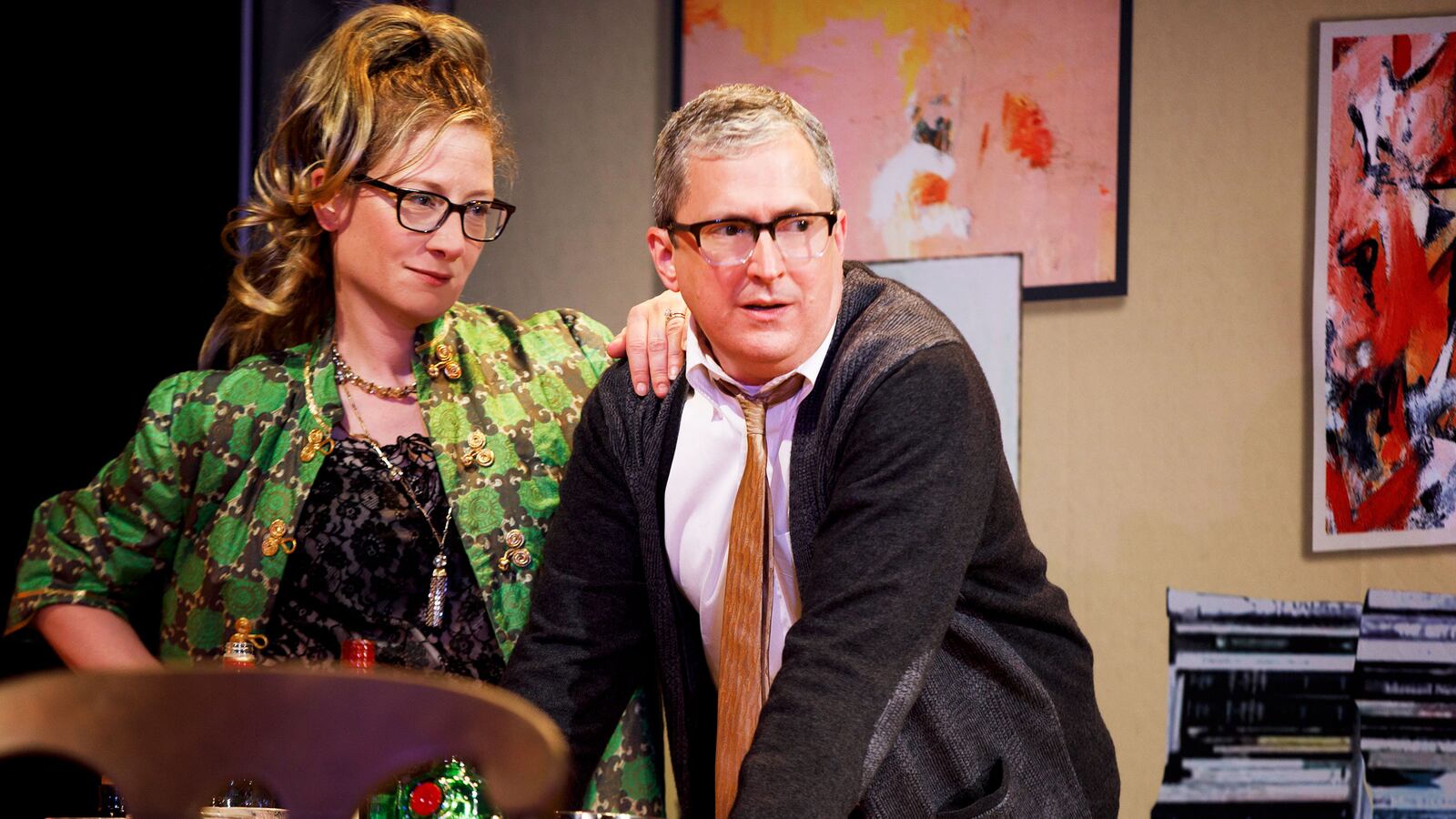For Kate Scelsa, playwright of Everyone’s Fine With Virginia Woolf, “Martha must be avenged.”
In a conversation with John Collins, artistic director of Elevator Repair Service, which is mounting the play at Abrons Arts Center, Scelsa says in the show’s program that for most of Edward Albee’s Who’s Afraid of Virginia Woolf?, on which Scelsa’s play is based, Martha is an “incredible feminist character,” ultimately defeated by “the idea of motherhood.”
Really? At the end of Who’s Afraid of Virginia Woolf? both George and Martha, most memorably played by Richard Burton and Elizabeth Taylor in Mike Nichols’ 1966 movie, seem—to me anyway—defeated by grief and regret. Defeated by the fallout of the strange life they have constructed. Yes, a child figures as a central pivot of that, but the experience is a shared one. The thing the couple has going for them is genuine care and love, beneath their battery and destruction of each other. It may just save them.
“That never really rang true for me,” says Scelsa of how she perceives Martha’s narrative destiny, and so she and ERS—best-known for its wonderful, epic distillation and reshaping of The Great Gatsby, Gatz (returning next January at New York City’s Skirball Center)—have brought the warring George and Martha back.
Along with them are junior academic Nick (Mike Iveson) and his wife, Honey (April Matthis)—here with the surname Sloane in tribute to characters from Gatz)—who, as we have known them from the original, are observers and casualties to the domestic war unfolding in front of them.

April Matthis, Mike Iveson.
Joan MarcusScelsa’s frenzied satire, directed in the same spirit by Collins himself, features feminism mixed with farce mixed with a literary rollercoaster ride, with the base ingredient of Albee’s chowed-down source material. Martha periodically springs into shouty renditions of “Everyone’s fine with Virginia Woolf,” and “I’m totes cool with Virginia Woolf” to the tune of “Who’s Afraid of the Big Bad Wolf?”
As Gatz and its Measure for Measure at the Public Theater showed, ERS doesn't simply remount classics. Its take on 'Woolf' both incorporates elements of Albee’s original while expanding on others, with whole passages given over to A Streetcar Named Desire and Blanche DuBois.
Other characteristics and inferences are subverted entirely and made a fast-paced, ironic mockery of. Will & Grace is mentioned, and so is A Doll’s House. Everyone is dressed in 1960s duds, but it feels like from a dressing-up box with both men and women in exaggerated drag. The set, by Louisa Thompson, is its own meaningful joke of collapsing walls.
The play’s script includes a list of about 40 cultural references, including to Gatz, which feels very self-referential (or playing to an extremely nerdy ERS fan base).
Right at the outset, Annie McNamara’s Martha tells Vin Knight’s George not to ruin the likelihood of them partner-swapping with Nick and Honey on this boozy night, and lays out their marriage thus: “You’re totally gay and I’m a little gay. We have an imaginary son and an imaginary dog, and I loved the dog more and you killed the son. And your parents. You have your job because of my father and you hate it, and I’ve never had a job. Because of my father. And I love it.”
Nick writes “mpreg” fiction, in which men get pregnant after sex with each other. Nick says he was pregnant, in fiction, once. “I gave myself terrible morning sickness. I wanted to really write an authentic experience.”
Scelsa takes cackling pins to Albee familiars; what you are left with are a sexually unfixed trio of George, Martha, and Nick, and a confused Honey, who notes that she once tried to read Mrs Dalloway on the beach but the novel and the beach are “not the ideal combo.”
The humor of the play, which fizzes with welcome weirdness at the beginning, is for those who know Who’s Afraid of Virginia Woolf? and are thus aware of what is being played with, and all the other literary references it packs in. Failing that, you have the energetic craziness of the company.
Martha believes that Tennessee Williams was “a pathetic alcoholic who projected his own victim complex and internalized shame about his sexuality onto totally unrealistic depictions of hysterical women.”
You might argue that. Then again, both Williams and Albee could also have just been creating vivid characters, or seeking to draw affinities between themselves, unable at that time to be out and gay as writers, and their female characters. They don’t simply have to have been in the business of creating insulting, camp grotesques.
Nick is “mostly gay,” says Honey; George is “very gay,” and Knight has a great moment where he drunkenly hits on Nick as a kind of piece of burlesque ending up with him high-kicking from behind a couch. But otherwise this viewer couldn’t see what was particularly “gay” about either man—unless George campily quoting and misquoting DuBois is another intended signifier. “Gay” is used as an ironic throwaway descriptor joke a lot; the point of this I’m-sure sophisticated repeat joke was lost on me.
At one stage Martha declares that “gay male writers use children as a metaphor, they are transparently talking about the tenuousness of their own egos in the face of an uncaring world!”
It’s hard to know if the character means this or is herself noting reductionist views of gay male authors and their reasons for encoding things in their writing. The play, tonally, is a little exhausting in this vein. It’s hard to know what anyone means about anything.
The couples behave to type, and against it. McNamara’s Martha calls time on every vestige of sexism around her—mention of Woody Allen is particularly likely to inspire ructions—and then snarks about it. George and she are primed to fight, and the play’s best broad comedy plays with the imminence of these squalls and the couple’s determined tamping down on the impulse to have them as Albee intended.
Even if the play’s own intentions are cloaked in clouds of parody and satire, for its first two acts its humor and serrated edges command our attention and laughter. Just where will George and Martha and Nick and Honey end up in this hall of theatrical mirrors? Then it heads towards a finale—George, not entirely in this world, stewarded by a feminist vampire—that, to this spectator at least, made little sense.

Vin Knight, Lindsay Hockaday.
Joan MarcusIf Martha is Scelsa’s concern, and the focus of her feminist reclamation, why do we spend the last stretch of the play with a babbling and mad George? Scelsa and Collins rightly aren’t afraid of re-interpreting Albee’s classic, but why bother bringing George and Martha back to life just to crudely cut them up and dismiss them?
As much as Scelsa may feel that a previous generation of gay male authors fetishized or clown-ified female characters, clown-ifying those creations and their authors doesn’t redress the balance, or make any meaningful sense of either character or creator.
Everyone’s Fine With Virginia Woolf is at the Abrons Arts Center until June 30. Book here.





